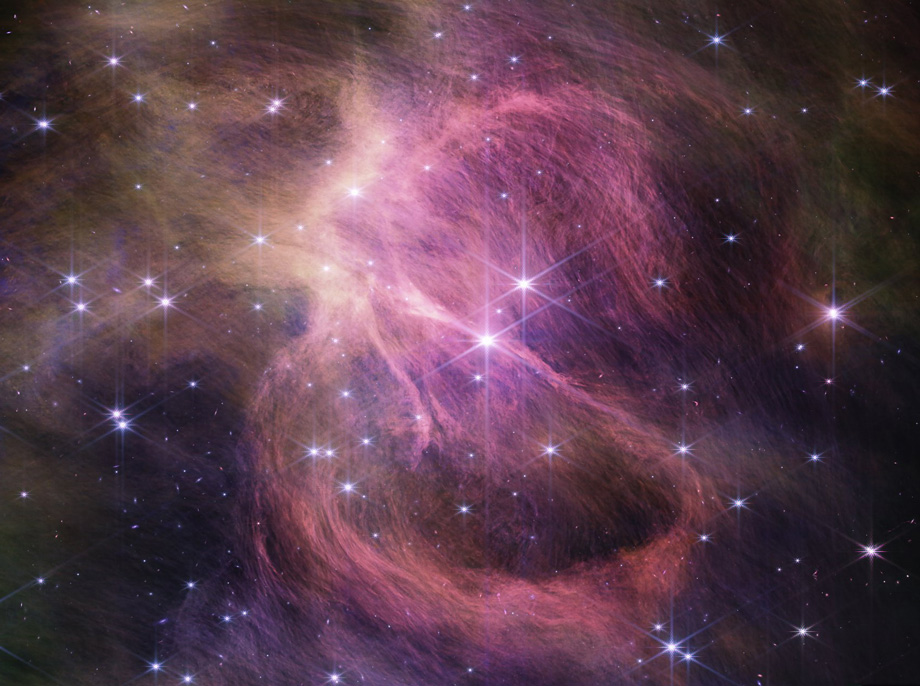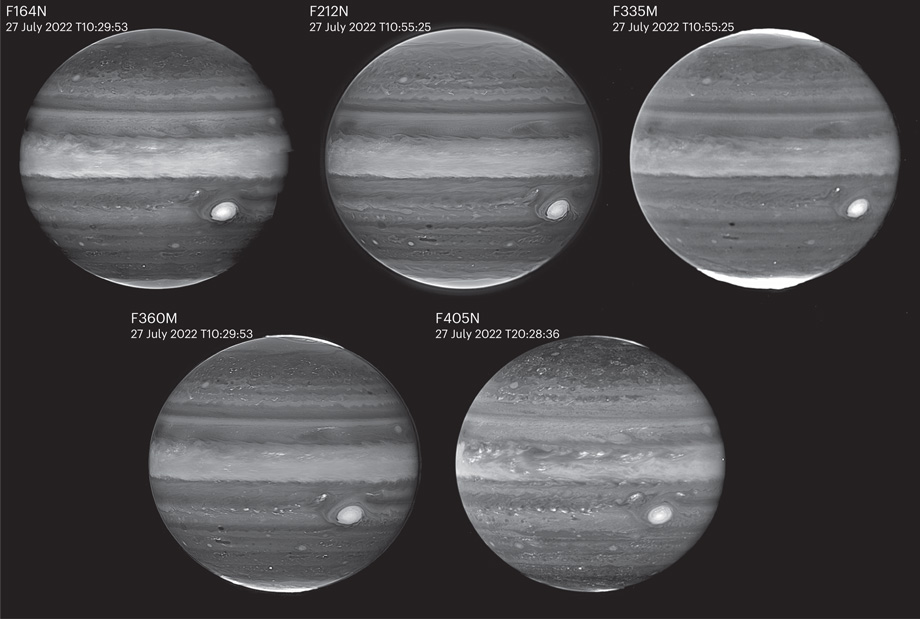On December 25, 2021, scientists from all over the world watched with bated breath as an Ariane 5 rocket launched from French Guiana. The increased attention had a simple explanation: the rocket was carrying the James Webb Space Telescope (JWST), whose creation took almost two decades and cost $10 billion.
Two years have passed since then. The Webb Telescope successfully entered orbit and flew to its working position in the vicinity of the Lagrange point L2, after which it began carrying out its scientific mission. What has the telescope already discovered during this time?
Look to the edge of the universe
The Webb Telescope’s key mission is to study the first stars and galaxies that formed shortly after the Big Bang. These objects are located at colossally huge distances from the Earth, and the wavelength of the light emitted by them has increased by so much that it has turned into infrared radiation. That is why the Webb Telescope is designed for observations in this range. It is, in certain respects, comparable to an astronomical time machine. The telescope gives astronomers the opportunity to see what our universe looked like in its “infancy” and study the objects which filled it at that time.
The Webb Telescope has already taken a number of steps in this direction. In particular, it was able to discover a whole bunch of galaxies that formed just a few hundred million years after the Big Bang. Currently, the record for the oldest galaxy is held by JADES-GS-z13-0, discovered by the telescope in September 2022. The measuring of its redshift showed that it is located at a distance of 13.4 billion light years from Earth. However, due to the expansion of the universe, the actual distance to the galaxy is about 33.6 billion light years. This means that we are seeing it now as it was just 320 million years after the Big Bang.

Image: JWST NASA
Another interesting find by the JWST was the oldest cluster of seven galaxies ever confirmed to date. They existed just 650 million years after the Big Bang.

Photo: iopscience.iop.org
The telescope also studied Eärendel, the most distant known star in the universe. The light it emits takes 12.9 billion years to reach Earth. Taking into account the expansion factor of the universe, Eärendel (or more precisely, its remnants, since the star became a supernova long ago) is now located at a distance of 28 billion light years from our planet.
Due to this huge distance, even the Webb Telescope would normally not be powerful enough to see the star. Fortunately for astronomers, there is a massive cluster of galaxies located on the line between Eärendel and Earth. Its gravity acted as a giant lens, amplifying the light of a distant star by 4000 times.
During its observations, the Webb Telescope was able to establish that Eärendel was a spectral class B star. This means its surface was twice as hot as the sun, and its luminosity exceeded that of our sun by a factor of a million. The telescope even revealed signs that the star had a companion.
Scientists hope that in the future the telescope will be able to find traces of so-called population III stars. We are talking about the very first luminaries in the universe, which could only exist in those times. They are believed to have a mass far greater than the most massive stars currently available.

Photo: JWST NASA
The Webb Telescope also took notice of black holes. Its current record is 570 million years. It was so long after the Big Bang that the most distant active black hole existed, found by a telescope. Despite its young age, the black hole is already 9 million times more massive than our Sun. For comparison, the mass of the black hole at the center of our galaxy is only 4 million Suns.

Image: NASA
This JWST’s discovery has again added fuel to the debate over how the first black holes managed to grow so quickly to such impressive sizes. Many astronomers believe that they formed not as a result of the death of stars with a subsequent increase in mass, but during the direct gravitational collapse of massive gas clouds that existed in the early universe. Perhaps new observations by the Webb Telescope will provide evidence for this hypothesis.
Stellar nurseries and nebulae
The Webb Telescope’s infrared vision is good not only for finding distant galaxies, but also for studying closer objects in our Milky Way hidden by dust clouds. Dust blocks visible light but allows infrared radiation to pass through. That is why the Webb Telescope has proven to be an indispensable tool in the study of stellar nurseries – regions of active star formation where new stars and planets are forming right now.
Thus, while observing the formation of stars in the Perseus region, the space telescope managed to find the smallest failed stars known to astronomers – several brown dwarfs with masses ranging from three to eight times that of Jupiter. Researchers believe that these are objects formed from gas and dust clouds, rather than exoplanets ejected from their systems.

Photo: JWST NASA
The Webb Telescope is also being used in the study of protoplanetary disks. During its operation, the telescope was able to confirm a long-standing hypothesis that icy particles play a key role in the process leading to the formation of rocky exoplanets.
Among other things, the telescope was able to detect methyl cation (CH₃+) in the protoplanetary disk around a young star for the first time. This compound plays a key role in the formation of complex organic molecules.

Photo: JWST NASA
The telescope also delighted space enthusiasts with many very impressive portraits of various nebulae – from the famous Pillars of Creation to the supernova remnant Cassiopeia A. These images are not only as beautiful as works of art, but also extremely informative. Thanks to its technical capabilities, the Webb Telescope was able during each of these surveys to identify structures which had previously escaped astronomers’ notice. This has made it possible to better understand exactly how many of the sky’s pearls were formed, and what processes are currently taking place within them.
Exoplanets
Another extremely important area of activity for the Webb Telescope is the study of exoplanets. Its instruments allow astronomers to analyze their atmospheres with precision not available with other telescopes. So far, the space observatory has lived up to its expectations. During its work, it has already made a number of interesting discoveries.
One of them was the detection of rock showers on the “swollen” exoplanet WASP-107b. The planet is a gas giant orbiting an orange dwarf 200 light years from Earth. It is comparable in size to Jupiter, but with only 12% of its mass. The exoplanet has a very extensive atmosphere, extending into the surrounding space for tens of thousands of kilometers.
The Webb Telescope was able to detect water vapor, sulfur and, most interestingly, silicate particles that form clouds in WASP-107b’s atmosphere. Clouds on Earth are formed from water droplets and water ice crystals, but on WASP-107b, whose atmosphere is heated to very high temperatures, this role is played by silicates. Their vapors rise upward, condense, and form sand clouds, which occasionally produce rain made of stone. Then the whole cycle repeats again.

Image: fys.kuleuven.be
A similar discovery was made during the study of another “inflated” gas giant, WASP-17b. This planet had quartz crystals in its atmosphere.

Image: NASA
Rock clouds are far from the only discovery by the Webb Telescope while studying the atmospheres of exoplanets. It managed to find methane in several of them. This compound is one of the main components of living matter, but previously it was quite rarely found on bodies outside our solar system. Of course, the JWST is now mainly finding methane in the atmospheres of hot exoplanets, which are unlikely to be habitable, but astronomers already have at least one more suitable candidate for life (more on that below).
Sometimes the absence of something also becomes a discovery. At the moment, the Webb Telescope is also studying the famous TRAPPIST-1 system. It consists of a red dwarf star that is orbited by seven rocky exoplanets, three of which orbit in the habitable zone.
The Webb Telescope has already explored two inner exoplanets. Its observations showed that the first has practically no atmosphere, and its surface temperature is 230 °C. In addition, it was found that the exoplanet’s albedo (surface reflectivity) makes it almost completely black.

Image: NASA
As for the second world, before the Webb Telescope’s observations, it was believed that it was similar to Venus and had a dense atmosphere that created a powerful greenhouse effect. This turned out not to be the case. According to the telescope’s findings, the average temperature on its daytime side is about 100 °C. Thus, the world most likely also lacks an atmosphere.
Perhaps the most interesting of the worlds studied by JWST has been K2-18 b, which orbits a red dwarf 120 light-years from Earth, and whose orbit lies in the habitable zone. Astronomers have long suspected that its surface may be covered by a global ocean.

Image: NASA
The Webb Telescope’s findings confirm this assumption. In addition to large amounts of water vapor, the telescope detected methane, carbon dioxide, and even signs of the possible presence of dimethyl sulfide. On Earth, this substance is only produced in observable quantities by living organisms. To be fair, NASA is still cautious about any conclusions and says that any determination on the presence of dimethyl sulfide requires additional evidence.
The solar system
The Webb Telescope is also used to study our Solar System. In particular, it has already made very impressive infrared portraits of all four giant planets. They not only demonstrated the processes occurring in their atmospheres, but also showed the complex structure of the rings surrounding them.

Photo: JWST NASA
In addition to the giant planets, the Webb Telescope has also observed their moons. And his data turned out to be quite interesting. For example, the telescope was able to capture a giant geyser produced by the subsurface ocean of Saturn’s moon Enceladus.

Photo: NASA
Jupiter’s moon Europa, which also has an ocean in its depths, also presented a surprise. The Webb Telescope managed to record it emitting carbon dioxide. This indicates the possible presence of carbon compounds in Europa’s ocean, making it potentially suitable for life.

Photo: JWST NASA
The telescope also studied smaller objects, in particular centaurs. This is the name given to bodies whose orbits lie between the orbits of Jupiter and Neptune. According to their characteristics, they occupy an intermediate position between asteroids and comets.
The Webb Telescope discovered carbon dioxide on one of these objects, named 39P/Oterma. Another centaur that the telescope turned its gaze to was Chariklo. JWST helped determine the size of the rings surrounding it and their structure.

Video: JWST NASA
The Webb Telescope has also made discoveries completely by accident. Thus, during the calibration of its instruments, the telescope was able to see one of the smallest Main Belt asteroids known to astronomers.
* * *
To conclude our mini-review, it is worth saying that it covers only the main discoveries of the Webb Telescope which have currently been announced to the public. There are actually a great many more. One must understand that the process of observing, analyzing data and then cross-checking it using other telescopes usually takes months, and sometimes years. Therefore, we can safely assume that the Webb Telescope’s most interesting finds still lay ahead.





